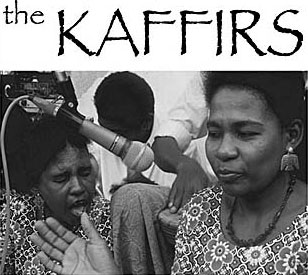
Rocorded live at the Barefoot Cafe in Colombo on Nov 22, 2008. On this date they were joined by Fakir singer Naina Mohammed Bawa.
Executive Producer: Jesse Hardman
Brief Introduction
The word Kaffir is an obsolete English term once used to designate African natives from the Eastern and Southern coasts. (In South Africa, it became a slur.) "Kaffir" derives in turn from the Arabic kafir, "unbeliever".
It is not clear whether the Portuguese name cafrinha was derived from English "Kaffir" after the English took over Sri Lanka, or came directly from the Arabic kafir in the 16th century, when the Portuguese were buying slaves from the Arab traders. During the 1500s, the Portuguese did indeed call the peoples of Southern Africa "Cafres" - "cafrinha" is a diminutive of "Cafre".
Kaffirs are proud to be Sri Lankans and in Sri Lanka nowadays are very proud of their name, and do not consider it as a racist word.
Kaffirs are proud to be Sri Lankans, they also acknowledge their African history. Kaffirs have an orally recorded history by the families who are descents of former Portuguese slave traders. While their exact place of origin along Africa’s east coast may never be known for sure because of a lack of documentation and conflicting oral histories, promoting their music allows for their future generations to better understand the Kaffir's history.
By 1444 the Portuguese had became involved in the African slave trade. They imported slaves from Africa to the maritime provinces of Sri Lanka. The Kaffirs were brought to Sri Lanka as a source of labour and were also used as soldiers to fight against the Sri Lankan kings, most probably in the Sri Lankan–Portuguese War, (Mulleriyawa (1562), Randeniwela (1630), Gannoruwa (1638)). Portuguese seafarers carried the first kaffirs to what was then Sri Lanka in the 1500s, most likely from Mozambique.
When Dutch colonialists arrived in about 1600, the Kaffirs worked on cinnamon plantations along the southern coast. The Kaffirs ancestors were chained up and forced by the Dutch to take on the Sri Lankan army. After the British entered Sri Lanka in 1796, the Kaffirs were further marginalised by an influx of Indian labourers who took most work on tea and rubber estates. Later, British colonists brought others to fight against Sri Lankan armies in "kaffir regiments." Both the Dutch and the British used the Kaffirs as a part of the naval force and for domestic work.
The descendants of the freed Kaffir slaves are still a distinctive community are mainly found in the former occupied territories of the Portuguese colonists, mainly near Puttalam, in the North Western Province of Sri Lanka but also in areas such as Trincomalee, Batticaloa and Negombo. There was some contact between the Kaffir and the Burghers, communities of partly European ancestry on the East coast of Sri Lanka.
Sri Lanka Kaffirs were originally Muslims, but now presently practice religions from Catholicism to Buddhism.
Sri Lanka Kaffir culture is a direct link back to their distant African past which is rapidly disappearing.
Baila is a form of dance music popular in Sri Lanka, originating centuries ago among the Kaffirs or Afro-Sinhalese communities (mixed communities consisting of Portuguese, African and native Sinhalese people), and was later amalgamated with European instruments and eastern and western rhythms, especially rhythms found in Spain and northern European folk music.
From Wikipidia
The Sri Lankan Kaffirs (cafrinhas in Portuguese, kapiriyo in Sinhala, and kapili in Tamil) are an ethnic group in Sri Lanka who are partially descended from 16th century Portuguese traders and the African slaves who were brought by them to work as labourers and soldiers to fight against the Sri Lankan kings.[3] They are very similar to the African populations in Iraq, Iran and Kuwait, and are known in Pakistan as Sheedis and India as Siddis. The Kaffirs spoke a distinctive creole based on Portuguese, the Sri Lanka Kaffir language, now extinct. Their cultural heritage includes the dance styles Kaffringna and Manja and their popular form of dance music Baila.
Audio Tracks
More about Kaffirs